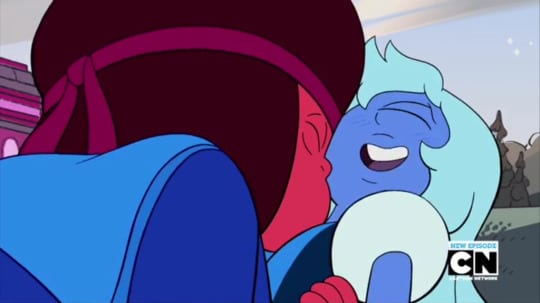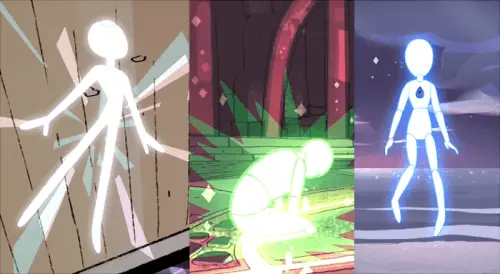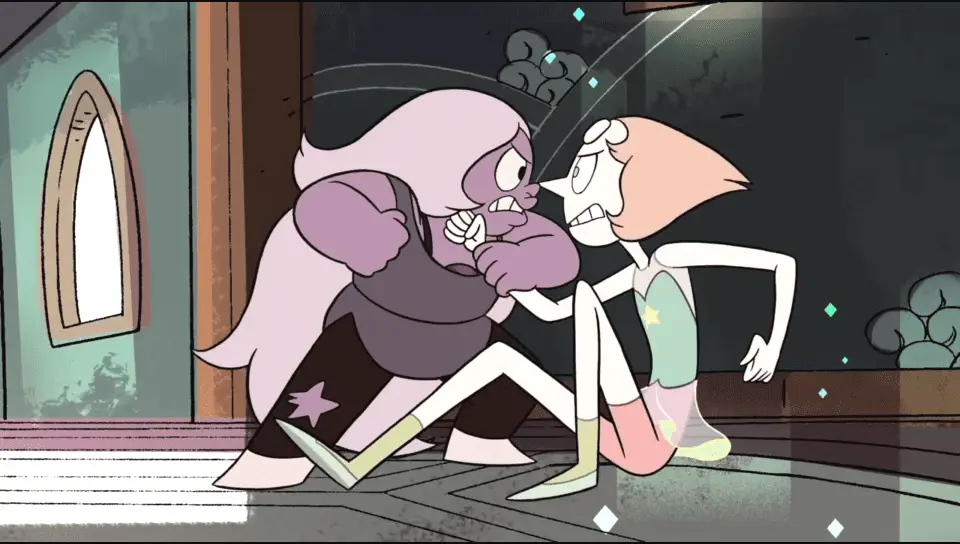Uniquely among children’s programming, Steven Universe is groundbreakingly queer friendly, and it is easy to understand why adult fans of Steven Universe would want to sexualize the fusion relationships on the show. Combine the use of all female pronouns for Gems with the mechanics of fusion as depicted on the show, a queer couple as canon (Ruby and Sapphire as Garnet), and the dearth of shows depicting healthy queer relationships even among adult programming, and you have a recipe for sexualized fanart. Indeed, there is no shortage of fanart devoted to depicting or discussing the imagined sexual dynamics of Garnet’s relationship and other fusion relationships on the show (after the latest episode, Amedot/Perimethist is gaining in popularity).
I get it. ‘Shipping is a huge part of any fandom, and though it isn’t the only way to ‘ship (one can ‘ship a friendship or a mentor/mentee relationship) the possibility of sexy times is often a huge part of ‘shipping, especially with romantic pairs. I enjoy my fair share of smutty fanart, too (Jareth/Sarah from Labyrinth is my kryptonite); sexy fanart/fanficion is one of the joys of the interwebs. However, within the context of show canon and its message, there are several reasons why it is important to not sexualize fusion relationships.

We can set aside an obviously non-sexual fusion relationship like Stevonnie because it is a fusion of two pre-pubescent children. I doubt anyone would want to sexualize the relationship as it stands now, though I’m sure there are Stevonnie ‘shippers out there who would love to see some kind of romantic (and potentially sexual) relationship develop as Steven and Connie age into their teen years and adulthood. I’ve avoided searching for any, but I’m sure its there.
On the other hand, while there may be some who sexualize the multi-gem fusions like Sugilite, Sardonyx, and Alexandrite, this is less common in my experience in the fandom. As much as we might want to talk about or fantasize sexy times between Ruby and Sapphire as Garnet, broadly applying a sexual lens for fusion makes both Stevonnie and multi-gem fusions uncomfortably squicky. I doubt even the most ‘ship-happy SU fan would go this far (then again, you never know with the internet).
Let’s grant, then, that not all fusion relationships have a sexual element to them. Some fusions are romantic (Garnet and Rose Quartz), and others are the result of relationships between friends (Stevonnie, Opal, Sardonyx, and Alexandrite) or even enemies (Malachite). The basis for fusion is the synchronization between the gems, or, in human terms, a relationship (“You know that my relationship is stable”—Garnet, “Jail Break,” emphasis mine). So what is wrong with sexualizing the romantic ones? Ruby and Sapphire have obvious romantic feelings for each other.

Not only do they kiss on screen (“Jail Break” and “Keystone Motel”), the romantic nature of their relationship has been confirmed by co-executive producer Ian Jones-Quarterly and writer/storyboard artist Joe Johnston. Is it appropriate to sexualize their relationship if it is confirmed to be romantic?
I think not, and not for the reasons you might think. First of all, I think it is important to accept what the characters themselves have to say about fusion relationships. Pearl calls Garnet a ‘perfect relationship’ (“Friend Ship”). Garnet, a permanent fusion for all intents and purposes, describes herself as a ‘conversation’ between Ruby and Sapphire (“Jail Break”). She calls Stevonnie an ‘experience’ (“Alone Together”). When talking to Greg about whether or not fusion with Rose was possible for him, Garnet tells him to “Get open, get honest, invent yourselves together. That’s fusion,” (“We Need to Talk”).
Although Garnet is the embodiment of Ruby’s and Sapphire’s romantic love for each other, she describes all fusion in undeniably non-sexual terms. While it is easy to blur the lines between romance and sex, the voices of those who self-describe as asexual ought to warn us against equating romantic feelings with sexual desire.
Second, we have to take into account gem anatomy as it is depicted on the show. Gems do not have bodies as humans do. Their visible forms are projections that they layer over a template that looks remarkably like an artist’s mannequin.

They actively control this projection when they regenerate from their gem (see “Steven the Sword Fighter” and “Reformed”), and can even change their form if they want to, even when they’re not regenerating (see, e.g., “Cat Fingers”).
Now stick with me, I’m going to make a couple of assumptions and then bring this all back around. Assumption one: most, if not all, gems would have very little understanding of human anatomy, especially anatomy that they cannot see, like genitalia or internal organs. From what we’ve seen on the show, Homeworld Gems look down on humanity and would be therefore uninterested in learning anything about their biology. Despite their alliance with humanity against the Homeworld, none of the Crystal Gems have shown any interest in human biology either. Imitation of outward form would be all that mattered if they wished to ‘blend in’ to their surroundings.
Assumption two: gems most likely do not ‘create’ internal organs or genitalia for themselves since they do not have knowledge of this kind of human anatomy and would have no need to imitate it even if they did. (I believe that Rose probably had to ‘create’ a uterus for herself in order to gestate and give birth to Steven, but that’s a topic for another entry). Join to these assumptions the fact that many gems are mass produced in a kindergarten (plus however the mass produced pearls are created) and it becomes overwhelmingly clear that gems are not sexual beings.
Third, and most importantly in my mind, the sexualization of fusion relationships falls into the trap of overly sexualizing the LGBTQIA community and misses the true message of fusion. Since the 1980s, American media has tended to depict members of the LGBTQIA community as defined by their sexual orientation. Look at what Benihoff and Weiss did to Loras on Game of Thrones: gay character? He can’t be a normal person who was in love with the man who was also his king; no, he must be obsessed with having sex with every man he can get his hands on.
Thus, it makes perfect sense that when people look at Steven Universe they would say, “Oh, they’re all queer? It must be all about sex.” However, this is a wrong, harmful, and derogatory stereotype of the LGBTQIA community. It reduces people to their sexual orientation and completely overlooks those who identify as asexual. Not only is it prejudiced and backward, it completely misses the true message of fusion: that all relationships are founded on consent. Think about it. Garnet is based on a romantic relationship, as is Rainbow Quartz (which may or may not have been primarily romantic on Pearl’s side, we don’t know Rose’s feelings for certain). Sugilite, Sardonyx, Alexandrite, Opal, and Stevonnie? All platonic friendships. Malachite isn’t even based on friendship, as Lapis and Jasper hate each other.
Nevertheless, all of these fusions require two things: consent and communication, two things necessary for a healthy relationship of any kind whether it be a marriage partnership, a friendship, or even a working partnership of enemies. I have heard people say that Jasper forced Lapis to fuse into Malachite (“Jail Break”), but if you watch the episode closely, despite being enemies Jasper still asks Lapis for her “consent” before they begin their fusion dance.

While it is also heavily implied that stable fusion requires love and mutuality, this isn’t necessarily romantic love. Sardonyx and Stevonnie are stable fusions built on platonic love and friendship. Moreover, Garnet makes it clear that Lapis’ and Jasper’s hatred for each other will eventually destroy Malachite, and perhaps others, because “a fusion like theirs is unstable, bound together by anger and mistrust. If that bond snaps, their anger will take over, and destroy,” (“Chille Tid”). They were able to create a fusion, but its lack of healthy communication will eventually undo it. The lesson? Stable fusion relationships require trust, communication, and consent.
It is no surprise then, that the greatest abomination of all for Garnet are the Cluster Gems, forced fusion of several gems to create monstrous mutants that lack cohesive form and personality. So visceral is her reaction to seeing them that her anger and sorrow almost cause her to unfuse (“Keeping it Together”). What distinguishes these gems from other fusions? The lack of consent. The implication is clear, consent is necessary for healthy fusion relationships, and, by consequence, any healthy relationship.
Again, I go back to the fact that this is a show that is deeply in tune with the LGBTQIA community, which is focused on the freedom to be oneself and the freedom to love who you love. Garnet embodies this: “I will fight for the place where I’m free, to live together and exist as me” (“Steven Universe Extended Theme”). Overly sexualizing the relationships depicted on this show buys into harmful stereotypes about the LGBTQIA community and perpetuates the notion that being LGBTQIA is about sex rather than about love and freedom of self expression.
One of the most amazing things about Steven Universe, in my mind, is that it seems to purposefully avoid the sexualization of its characters, even the ones in an obviously romantic relationship. This normalizes queer relationships in a way that sexualizing actively undermines. Sidestepping the sexual component makes it easier for audiences to equate a healthy queer relationship with any other healthy relationship on the show. In other words, fusion teaches the audience that a relationship is healthy not based on who is in it (whether queer or not), but based on whether or not the participants are equals that are open and honest in their communication.

All this isn’t to say that we can’t create pieces of fanart or fanfiction that depict a sexual dynamic between characters. However, is our responsibility in the fandom to keep these pieces separate from show canon as they can distract from the message of the show, the message that above all, healthy and stable relationships of any kind require consent and communication.

